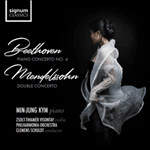
Welcome to Hyperion Records, an independent British classical label devoted to presenting high-quality recordings of music of all styles and from all periods from the twelfth century to the twenty-first.
Hyperion offers both CDs, and downloads in a number of formats. The site is also available in several languages.
Please use the dropdown buttons to set your preferred options, or use the checkbox to accept the defaults.

| Zsolt-Tihamér Visontay (violin), Min-Jung Kym (piano), Philharmonia Orchestra, Clemens Schuldt (conductor)» More |
The piece clocks in at nearly 40 minutes, and every one of them is entrancing. The grand first movement Allegro, a spacious concertante sonata form with double exposition for soli and orchestra and cadenzas for both soloists, takes up more than half the piece and displays precisely that perfect command of form which Mendelssohn seems to have been born with. The Adagio opens with an orchestral introduction setting out the main theme, which is then taken up by the piano, the violin only entering later, after which the orchestra has little to contribute while the two soloists engage in an extended, almost operatic dialogue. The effervescent Allegro molto finale, in sonata form with a pell-mell first and a sweetly lyrical second subject, is an utter delight of post-Mozartian charm and tremendous energy, culminating in a breathtakingly brilliant conclusion.
from notes by Malcolm MacDonald © 2013
 Beethoven: Piano Concerto No 4; Mendelssohn: Double Concerto Beethoven: Piano Concerto No 4; Mendelssohn: Double ConcertoSteinway Artist Min-Jung Kym makes her recording debut with Beethoven’s Piano Concerto No 4 and Mendelssohn’s Double Concerto, in which she is joined by violinist and regular duo partner Zsolt-Tihamér Visontay.» More |

